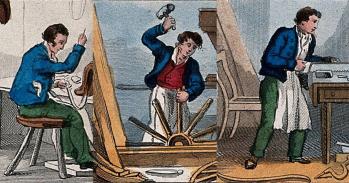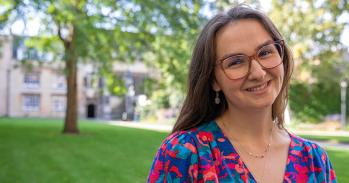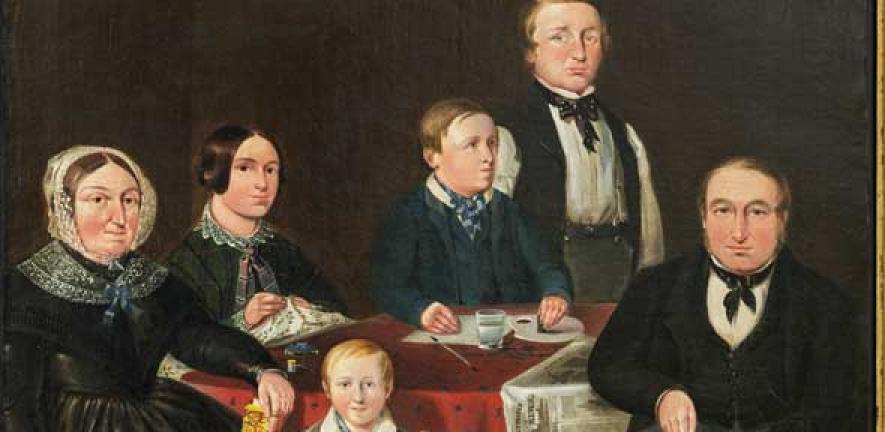
For three centuries one family made an unacknowledged contribution to the life of Cambridge, first as cooks and inn keepers and later as artists and craftsmen. A series of Open Cambridge events will explore the untold story of the Leach family.
For three centuries one family made an unacknowledged contribution to the life of Cambridge, first as cooks and inn keepers and later as artists and craftsmen. A series of Open Cambridge events will explore the untold story of the Leach family.
Frederick began his career as apprentice to a stonemason before working alongside his elder brother in his painting and decorating business. In 1862, aged 25 and with a £300 loan from family and friends, he set up his own business in City Road.
Tamsin Wimhurst
Early in the 19th century a young man called Richard Hopkins Leach (1794-1851) walked from Cambridge to Cornwall – a journey of more than 300 miles – to look for work. He kept a diary of his adventures, recording them in pictures as well as words. His journal gives a vivid picture of the pleasures and hardships of travel on foot through the rural landscape also documented by better-known travellers such as William Cobbett whose Rural Rides became a classic.
Richard Leach’s travel journal for the years 1814 to 1817, with its descriptions, maps and sketches of places he visited en route, is one of many items on show to the public for the first time at the Museum of Cambridge as part of the 2014 Open Cambridge programme. These objects tell the remarkable stories of a family whose history was for almost 300 years intertwined with that of some of Cambridge’s most iconic buildings – from public houses to colleges. 
Carefully inscribed in the pages of a small notebook, Richard’s observations reveal a young man fascinated by all that he sees around him in a country emerging from the Napoleonic wars. On his travels, he records meeting newly released French prisoners and encounters the suspicions of dialect-speaking locals in the West Country, who take Richard and his companion for deserters.
On Thursday 2 June 1814, while walking from Marlborough to Tidworth in Wiltshire Richard writes that he ‘was glad to enter the public house (the old Bull) our appetites being unusually keen with waiting so long for dinner we had an excellent relish for our bread & cheese & beer the landlord said it was long since he had seen a strange face & was sorry he could produce no better accommodation to the weary but he would sleep on long feathers himself if we would put up with his bed in deference to age we declined his offer….’
The reference to ‘long feathers’ is one of many compelling historical details. Short downy feathers produce the softest and snuggest bedding while long feathers with their sharp quills are less luxurious.
Richard returned to Cambridge where, half a century later, his second son Frederick was to found a small decorating firm that expanded to provide a wide range of skills and work in partnership with some of the country’s best known designers and architects. Among them were William Morris, father of the arts and crafts movement, and George Bodley, the Gothic revival architect.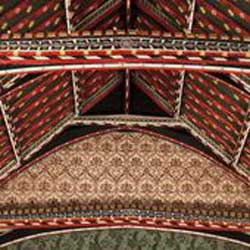
A series of Open Cambridge events are the first steps to bringing the Leach family to public attention and, in the process, revealing their input to some of the Cambridge’s most striking interior design – in particular the medieval-inspired and highly decorative schemes of the arts and crafts movement.
At the Museum of Cambridge, an exhibition titled Cooks and Colours explores what’s known about the early generations of the family. At All Saints’ Church, the story of Frederick Richard Leach is unfolded with an emphasis on his City Road premises which were recently demolished for redevelopment. The David Parr House charity recorded and salvaged what they could before the developers moved in. The exhibition at Michaelhouse showcases the photos of Hannah Boatfield who visited the various locations where F R Leach & Sons’ work can still be seen and recorded what she saw.
Cooks and Colours has been curated by Tamsin Wimhurst, a local historian and trustee of the David Parr House. “This is an exciting opportunity for the public to see a collection that is usually in private hands,” she said. “Among the family archive are oil paintings of 19th-century Cambridge by Richard Leach and a pair of silver buckles that belonged to Barnett Leach, Richard’s grandfather who was the master cook at Trinity College. A waistcoat that was sent to the Leach family during the 1850s, but never sewn together, has been recreated. Also, for the first time, a sign painted by Richard Leach for the John Gilpin, a pub that use to stand on Gold Street, has been taken off the wall of the museum and displayed so that both sides can be seen.”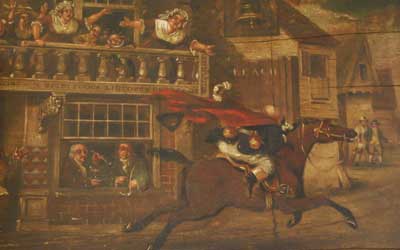
The delightfully exuberant sign illustrates the story of John Gilpin, a poem very popular in the late 18th century. Wimhurst said: “A London linen draper sets off on a journey on horseback. His horse has its own ideas and refuses to stop at the village where the draper’s family are waiting. It gallops off and Gilpin loses his hat, wig and coat, and the wine bottles around his waist are broken. The horse then turns round and gallops back. One side of the sign shows Gilpin’s outward journey and the other his return.”
In 1849 Richard Leach painted a striking portrait of his family. It shows (from left to right) his wife Isabella Leach, daughter Isabella McLean Leach, son John McLean Leach (with cat), son Frederick Richard Leach, son Barnett Leach, and finally Richard himself (seated). Isabella holds Richard's travel journal. It's thought that the face of the artist was painted by his son Barnett (standing behind the table). 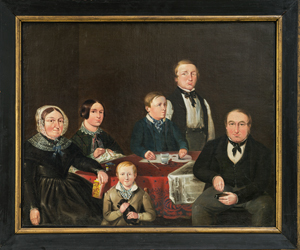
A string of famous architects contributed to the heritage of Cambridge – among them Christopher Wren, James Gibbs and George Gilbert Scott. Much less well known are the generations of local craftsmen who helped to create both the town’s domestic buildings and the masterpieces of design that each year attract thousands of tourists to visit Cambridge and marvel at its stained glass windows, stone and wood carving, decorative design and painted interiors.
At least half a dozen generations of the Leach family are known to have contributed to the life of Cambridge, both town and gown. Their names rarely appear in the annals of history which inevitably focus on the powerful benefactors who indirectly paid their wages and the architects, interior designers and engineers who directed them.
It is the input of these largely overlooked artisans, whose route into professional life was through apprenticeship rather than academic study, that Wimhurst hopes to highlight. Documentary evidence of their business and practical skill is found in archives recording their work in account books and advertising cards while visual evidence of their creativity as artists survives in buildings throughout the city, including All Saints Church on Jesus Lane and St Clement’s Church on Bridge Street.
Preliminary research into the Leach dynasty has traced their presence in Cambridge back to 1675 when Barnett Leach and his wife Margaret lived in the Archers Inn in St Andrew’s Street that was once located near to where the main post office is now.
Barnett and Margaret’s grandson, Barnett III, became the first college cook in the family and was appointed ‘Master Cook’ at Trinity College in 1770. “At this time college cooks were self-employed. They rented out their pots, pans and crockery to the colleges – and often ran other businesses alongside their daily work,” said Wimhurst. Barnet III’s son, yet another Barnett, followed his father as master cook at Trinity and also worked as a bacon dealer and ran the Pickerel Inn on Bridge Street, the oldest parts of which date to the 1500s.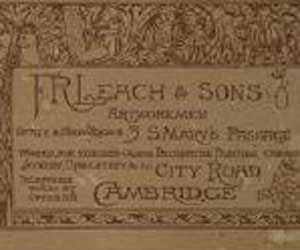
It was Richard Hopkins Leach, second son of Barnet IV, who laid the foundations for future generations to become artisans – sign writers and stained glass makers, builders, stone carvers and cabinetmakers. Returning from his travels, Richard was apprenticed to an engraver and became a skilled jobbing artist, earning his living from house painting, lettering, portraiture and college work. He is best known as a painter of inn signs, four of which can be seen at the Museum of Cambridge.
Richard’s son, Frederick Leach came to be regarded as Cambridge’s finest master artworkman – a term used in his tradesman’s card to describe his combination of skills. Wimhurst said: “He began his career as apprentice to a stonemason before working alongside his elder brother in his painting and decorating business. In 1862, aged 25 and with a £300 loan from family and friends, Frederick set up his own business in City Road.”
FR Leach expanded from house and shop painting into ecclesiastical and civic arts, crafts and decoration. In the 1871 census Frederick is described as ‘Church Ornament and Glass Painting master employing 12 men and 2 boys’ and in the 1881 census as ‘Painter: Designer and Art Worker employing 28 men, 2 women and 6 boys on painted decorations, stained glass and making furniture’.
The firm was at its most successful in the 1880s when it undertook some impressive commissions. Frederick worked with the designer William Morris on the staircase of St James’s Palace in London, a commission that encouraged him to open an office in Great Ormond Street. The firm’s trade cards and accounts book reveal that its reputation spread far and wide. In Cambridge, Frederick collaborated with the architect George Bodley, an exponent of English gothic revival.
Examples of the work of FR Leach’s team of craftsmen survive throughout Cambridge. At All Saints’ Church, the firm painted the walls, with most of the work done free of charge by Frederick himself. The nave and transept roof of Jesus College Chapel was his first commission for Bodley and Morris. At St Botolph’s Church, the firm decorated the chancel roof. A commission for painting and stained glasswork at Queens’ Old Hall included 885 lead castings gilded for decoration.
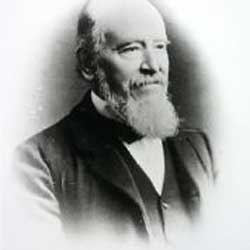 David Parr House is seeking volunteers to help them research more about the fascinating history of the Leach family. Anyone interested should email davidparrhouse@gmail.com
David Parr House is seeking volunteers to help them research more about the fascinating history of the Leach family. Anyone interested should email davidparrhouse@gmail.com
Free, drop-in events relating to the Leach family take place on Friday 12, September and Saturday 13, September. For an online Open Cambridge programme go to www.cam.ac.uk/open-cambridge or phone 01223 766766 for a printed programme.
The exhibition Cooks and Colours has been made possible by support from the Heritage Lottery Fund.
Inset images: pages from Richard Hopkin Leach's journal (copyright Ric Leach), Queens' College Old Hall with decoration by FR Leach (copyright Hannah Boatfield), John Gilpin pub sign by Richard Hopkins Leach (copyright Museum of Cambridge), portrait of the Leach family by Richard Hopkins Leach (copyright Ric Leach), FR Leach trade card (copyright Ric Leach), FR Leach (copyright Ric Leach).
For the Open Cambridge programme, and all details of events linked to the Leach family story, go to opencambridge.cam.ac.uk. Cooks and Colours opens on Saturday 6 September. The Museum of Cambridge charges an entrance fee but will be open free of charge for one day only on Saturday, 13 September, 10.30am to 5pm, for Open Cambridge.
The text in this work is licensed under a Creative Commons Licence. If you use this content on your site please link back to this page. For image rights, please see the credits associated with each individual image.


